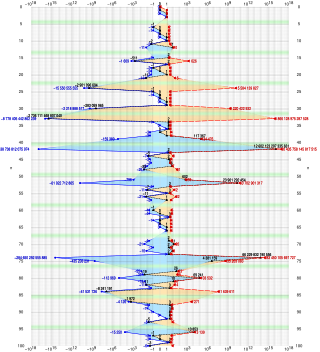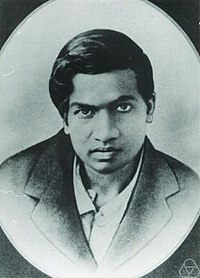In number theory, an arithmetic, arithmetical, or number-theoretic function is generally any function f(n) whose domain is the positive integers and whose range is a subset of the complex numbers. Hardy & Wright include in their definition the requirement that an arithmetical function "expresses some arithmetical property of n". There is a larger class of number-theoretic functions that do not fit this definition, for example, the prime-counting functions. This article provides links to functions of both classes.

In mathematics, a Diophantine equation is an equation, typically a polynomial equation in two or more unknowns with integer coefficients, for which only integer solutions are of interest. A linear Diophantine equation equates to a constant the sum of two or more monomials, each of degree one. An exponential Diophantine equation is one in which unknowns can appear in exponents.
In number theory, Euler's conjecture is a disproved conjecture related to Fermat's Last Theorem. It was proposed by Leonhard Euler in 1769. It states that for all integers n and k greater than 1, if the sum of n many kth powers of positive integers is itself a kth power, then n is greater than or equal to k:
In mathematics, a transcendental number is a real or complex number that is not algebraic: that is, not the root of a non-zero polynomial with integer coefficients. The best-known transcendental numbers are π and e. The quality of a number being transcendental is called transcendence.
In number theory, Waring's problem asks whether each natural number k has an associated positive integer s such that every natural number is the sum of at most s natural numbers raised to the power k. For example, every natural number is the sum of at most 4 squares, 9 cubes, or 19 fourth powers. Waring's problem was proposed in 1770 by Edward Waring, after whom it is named. Its affirmative answer, known as the Hilbert–Waring theorem, was provided by Hilbert in 1909. Waring's problem has its own Mathematics Subject Classification, 11P05, "Waring's problem and variants".

In mathematics, and specifically in number theory, a divisor function is an arithmetic function related to the divisors of an integer. When referred to as the divisor function, it counts the number of divisors of an integer. It appears in a number of remarkable identities, including relationships on the Riemann zeta function and the Eisenstein series of modular forms. Divisor functions were studied by Ramanujan, who gave a number of important congruences and identities; these are treated separately in the article Ramanujan's sum.

In arithmetic and algebra, the cube of a number n is its third power, that is, the result of multiplying three instances of n together. The cube of a number or any other mathematical expression is denoted by a superscript 3, for example 23 = 8 or (x + 1)3.

A powerful number is a positive integer m such that for every prime number p dividing m, p2 also divides m. Equivalently, a powerful number is the product of a square and a cube, that is, a number m of the form m = a2b3, where a and b are positive integers. Powerful numbers are also known as squareful, square-full, or 2-full. Paul Erdős and George Szekeres studied such numbers and Solomon W. Golomb named such numbers powerful.
The interesting number paradox is a humorous paradox which arises from the attempt to classify every natural number as either "interesting" or "uninteresting". The paradox states that every natural number is interesting. The "proof" is by contradiction: if there exists a non-empty set of uninteresting natural numbers, there would be a smallest uninteresting number – but the smallest uninteresting number is itself interesting because it is the smallest uninteresting number, thus producing a contradiction.
In number theory, a formula for primes is a formula generating the prime numbers, exactly and without exception. Formulas for calculating primes do exist; however, they are computationally very slow. A number of constraints are known, showing what such a "formula" can and cannot be.
1729 is the natural number following 1728 and preceding 1730. It is the first nontrivial taxicab number, expressed as the sum of two cubic numbers in two different ways. It is known as the Ramanujan number or Hardy–Ramanujan number after G. H. Hardy and Srinivasa Ramanujan.
In number theory, the generalized taxicab numberTaxicab(k, j, n) is the smallest number — if it exists — that can be expressed as the sum of j numbers to the kth positive power in n different ways. For k = 3 and j = 2, they coincide with taxicab number.
In mathematics, in the field of number theory, the Ramanujan–Nagell equation is an equation between a square number and a number that is seven less than a power of two. It is an example of an exponential Diophantine equation, an equation to be solved in integers where one of the variables appears as an exponent.
1728 is the natural number following 1727 and preceding 1729. It is a dozen gross, or one great gross. It is also the number of cubic inches in a cubic foot.
Brocard's problem is a problem in mathematics that seeks integer values of such that is a perfect square, where is the factorial. Only three values of are known — 4, 5, 7 — and it is not known whether there are any more.
In mathematics and statistics, sums of powers occur in a number of contexts:
In number theory, the Lander, Parkin, and Selfridge conjecture concerns the integer solutions of equations which contain sums of like powers. The equations are generalisations of those considered in Fermat's Last Theorem. The conjecture is that if the sum of some k-th powers equals the sum of some other k-th powers, then the total number of terms in both sums combined must be at least k.

In the mathematics of sums of powers, it is an open problem to characterize the numbers that can be expressed as a sum of three cubes of integers, allowing both positive and negative cubes in the sum. A necessary condition for an integer to equal such a sum is that cannot equal 4 or 5 modulo 9, because the cubes modulo 9 are 0, 1, and −1, and no three of these numbers can sum to 4 or 5 modulo 9. It is unknown whether this necessary condition is sufficient.

In mathematics, the sum of two cubes is a cubed number added to another cubed number.












